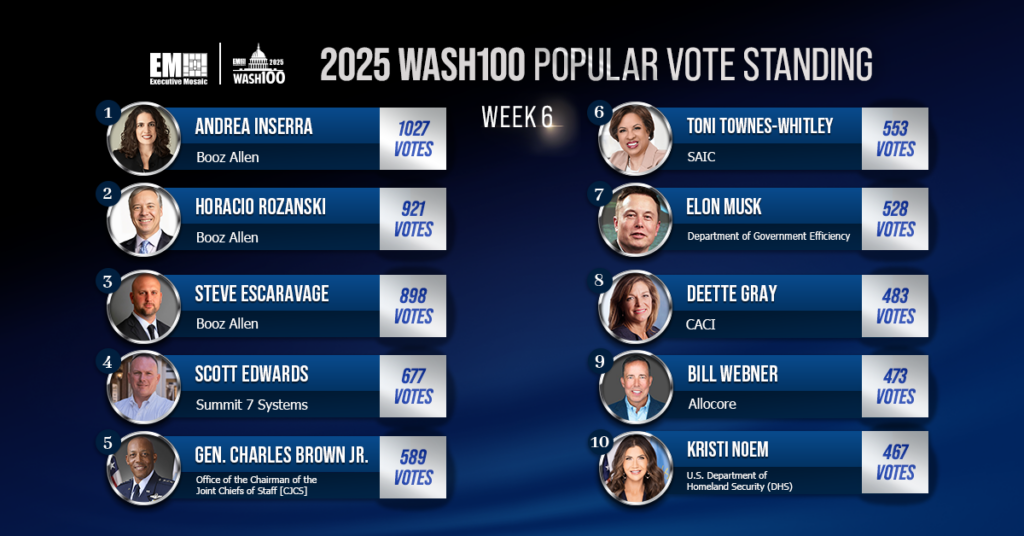Executive Mosaic is honored to announce Air Force Secretary Frank Kendall as a winner of the 2023 Wash100 Award for driving strategic initiatives for the Air and Space Forces to improve their abilities to project power.
Kendall has been selected four times to Executive Mosaic's annual list of leaders who shape the government contracting narrative in the 10-year history of the award. His previous Wash100 inductions occurred when he was still the undersecretary for acquisition, technology and logistics at the Department of Defense.
Kendall assumed responsibility as secretary of the Department of the Air Force in July 2021 and has led efforts to train and equip the two service branches under DAF.
At the Potomac Officers Club’s 2022 Air Force Summit in July, Kendall highlighted the need to quickly bring military capabilities into the hands of warfighters and said that he is willing to undergo risks to do just that.
“I’m not very interested in experimentations or demos. I’m prepared to accept risk and move towards fielding with engineering and system development programs that lead to production and lead to production at scale,” Kendall said at the summit.
“If the risk appears to be manageable and we have reasonable mitigations, we need to get on with it and get towards production,” he noted. “The result of that inevitably would be some cost and schedule hiccups as we go forward, but I’m afraid we’re going to have to pay that price to get to where we need to go.”
During the event, Kendall cited his two priorities when he assumed his role at the Air Force and those are putting the service branch in a better position to compete with China and strengthening the military branch’s technological capability.
“So this is an ongoing quest for technological military superiority that we have got to move quickly in, but we also have to make the right choices about what we invest in,” Kendall said.
At a fireside chat in July, he explained that China has identified the aircraft carriers, satellites and other “high value targets” that the U.S. relies on to project power and has developed conventional precision munitions to attack those assets.
“We have to reorient ourselves and develop a sense of urgency about out-thinking, out-spending, out-smarting a very capable adversary,” he continued.
Kendall said he has seven operational imperatives for the service branch to modernize to counter emerging threats and challenges and one of those is the need to achieve operationally optimized Advanced Battle Management System and Joint All-Domain Command and Control.
“This imperative is the Department of the Air Force component of Joint All Domain Command and Control. It is intended to better define and focus DAF efforts to improve how we collect, analyze, and share information and make operational decisions more effectively than our potential adversaries,” Kendall said Thursday at a symposium.
The other six imperatives are defining resilient and effective space order of battle and architectures; achieving moving target engagement at scale in a challenging operational environment; defining the B-21 Long Range Strike family-of-systems; defining the Next Generation Air Dominance system-of-systems; defining optimized resilient basing, sustainment and communications in a contested environment; and readiness of the Department of the Air Force to transition to a wartime posture against a peer competitor.
He described these imperatives as a “list of seven things that I felt that we had to do better at to be successful operationally in conventional power projection.”
In June, Kendall said at an event that engineering and manufacturing development efforts for the NGAD project are now underway and the service expects the next manned fighter platform and related systems to be ready by the end of 2030.
The following month, the secretary announced that the service decided to cancel the drone wingman concept for the B-21 Raider bomber after performing some analysis.
“The idea of a similar range collaborative combat aircraft is not turning out to be cost effective, so it looks like we’re not going to go that direction,” Kendall said in July.
It was announced in October 2022 that the Air Force was scheduled to begin flight experiments with a Boeing-built combat drone, dubbed MQ-28 Ghost Bat.
Kendall said at a conference in September that Ghost Bat could be used as a potential testbed that could help the service understand how to interface unmanned systems with the fighter wing’s daily operations such as battle management, sustainment and mission planning.
In April 2022, the Department of the Air Force officially named its Ground Based Strategic Deterrent intercontinental ballistic missile system the LGM-35A Sentinel, which is set to replace the Minuteman III ICBM system as the ground-based leg of the U.S. nuclear triad.
“The name Sentinel recognizes the mindset that thousands of Airmen, past and present, have brought to the deterrence mission, and will serve as a reminder for those who operate, secure, and maintain this system in the future about the discipline and responsibility their duty entails,” Kendall said then.
When it comes to the fifth-generation fighter, Kendall said the service still sticks to its plan to buy a total of 1,763 Lockheed Martin-built F-35 fighter jets despite its decision to reduce procurement of the aircraft in its fiscal year 2023 budget request.
“The numbers come back up” after 2023, Kendall said. “We are not changing the goal.”
In August, he received an update on the maintenance and modernization of the Pratt & Whitney-made F135 engines at the Tinker Air Force Base’s Oklahoma City Air Logistics Complex.
“The efforts by the men and women of the Oklahoma City Air Logistics Complex to repair F135 engine modules faster and more efficiently is beginning to address the gap between where F-35 sustainment currently is and where it needs to be,” Kendall said during his visit at the Tinker AFB.
Kendall also led efforts to advance STEM education. The Department of Defense and the Air Force announced plans to establish a research center affiliated with a historically black college or university in a push to tap into the next generation of science, technology, engineering and mathematics workforce.
“The partnership opportunity we’re announcing today will create a major contributor to the Space and Air Forces’ rapidly advancing tactical autonomy program and it will strengthen collaboration between the Department of the Air Force and the outstanding talent in our nation’s Historically Black Colleges and Universities,” Kendall added.
When it comes to space efforts, Kendall presented to Vice President Kamala Harris, who also chairs the National Space Council, a list of commercial space ideas through a six-page memo.
Under Kendall’s leadership, the Department of the Air Force has initiated efforts to address climate risks. In October, the service issued an action plan detailing three key objectives to address climate change’s impact on its operational capability, resilience and readiness and these are maintaining air and space dominance, making climate-informed decisions and optimizing energy use and pursuing alternative energy sources.
“Our mission remains unchanged, but we recognize that the world is facing ongoing and accelerating climate change and we must be prepared to respond, fight, and win in this constantly changing world,” Kendall said then.
Kendall also recognizes the importance of working with commercial partners and allies to modernize capabilities.
“When we say one team, one fight — industry and our international partners are part of that team,” he said at an air show in the U.K. “As we work together to accelerate change, we want to tap into the intellectual capital and creativity industry brings to the table, and this includes our international partners.
Executive Mosaic congratulates Frank Kendall and the Air Force organization on their Wash100 win. Don't forget to cast 10 votes by April 28 for this year's ranking of winners at Wash100.com.





